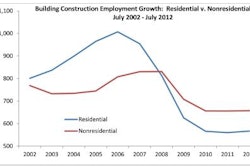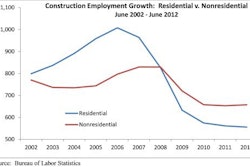News reports about the national economy often include references to the unemployment rate, that is, the number of people who are jobless, looking for jobs and available for work. Although it’s the unemployment rate that gets all the press, the real story in is in the employment numbers and worker trends.
The U.S. Bureau of Labor Statistics tracks employment and unemployment in the U.S. through monthly telephone surveys. Its results are published on its website and referenced throughout the media as an indicator of economic health. The May 2012 unemployment rate was 8.2 percent. In 2006 and 2007, unemployment stood at 5 percent or lower. In 2008, the percentage of unemployed Americans started to rise, topping out at 10 percent in October 2009.
As the national unemployment rate rose, so did the construction unemployment rate. But that rate carried with it far more alarming percentages – 19.2 percent in May 2009, 27.1 percent in February 2010. Then we started to see the unemployment numbers decline, to 21.8 percent in February 2011 and 14.2 percent in May 2012. (Note: BLS seasonally adjusts national unemployment numbers; it does not for industry employment numbers like Construction.)
Breaking down the numbers
On the surface, the falling unemployment rate in construction makes it appear the construction industry is gaining jobs. But that’s not the story. The number of people employed in the construction market over the last two and a half years has remained fairly level, at about 5.5 million in the workforce, down from around 7.7 million in 2006 and 2007. What that means is unemployed construction workers have left, and are still leaving, the construction market. Were these employees talented industry veterans or people who joined the workforce during the boom? Did they leave the work force altogether, or did they move into different industries?
This worker exodus from the construction industry is alarming. Readers often tell me of their difficulties finding “good” employees. Additionally, a recent ManpowerGroup survey reported 49 percent of U.S. employers struggle to fill mission-critical positions. At the top of ManpowerGroup’s list of “hardest jobs to fill in 2012” — “Skilled Trades.” Where will construction companies find the skilled workers they need? To what degree can equipment and jobsite technologies replace skilled workers?
I invite you to call or email me with your thoughts on construction employment at (920) 568-8321 or [email protected]. Tell me what you have observed and experienced in your market in regard to construction employment. Is it hard for you to find skilled employees? Do you define “good” workers differently than “skilled” workers? Do you plan to hire new employees this year? What do you look for in an employee?


















